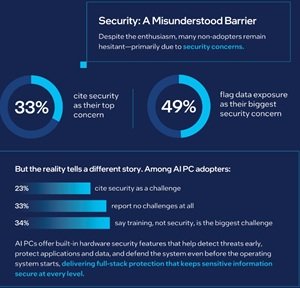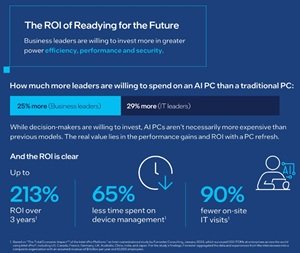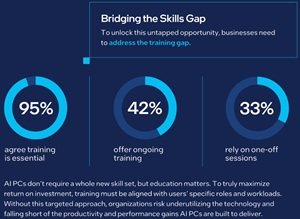Education
AI Shifting from Cloud to PCs — Campus Technology
Report: AI Shifting from Cloud to PCs
A recent Intel-commissioned report identifies a significant shift in AI adoption, moving away from the cloud and closer to the user. Businesses are increasingly turning to the specialized hardware of AI PCs, the survey found, recognizing their potential not just for productivity gains, but for revolutionizing IT efficiency, fortifying data security, and delivering a compelling return on investment by bringing AI capabilities directly to the edge.
All that and more is detailed in the AI PC Global Report from Intel, which surveyed 5,050 business and IT decision-makers across 23 countries, showing momentum for on-device AI acceleration.
“Businesses are already well-versed in the productivity gains that AI delivers for tasks like search optimization or language translation. Consumed as a cloud service, this type of day-to-day AI use is driving adoption. But for businesses looking to extend IT efficiency, better protect sensitive data, and reduce long-term costs, AI PCs are fast becoming the go-to option,” the report noted.
“One of the most powerful advantages of AI PCs is the ability to run AI workloads locally, offline and privately, without sending sensitive data to the cloud.”
Some data points to back that up include:
- Security benefits of local AI: AI PCs come with built-in hardware security features that help detect threats early, protect applications and data, and defend the system even before the operating system starts. This provides full-stack protection and is especially valuable for regulated industries like healthcare, finance, and legal services, where data privacy and compliance are paramount.
- 49% of non-adopters cite data exposure as their top security concern: This concern was flagged by nearly half of respondents who haven’t yet adopted AI PCs. Intel counters this by emphasizing that one of the most powerful advantages of AI PCs is the ability to run AI workloads locally, offline and privately, without sending sensitive data to the cloud. By keeping data on the device, organizations can reduce exposure risks while still benefiting from real-time AI capabilities.
- Only 23% of adopters report security as a challenge, and 33% report no challenges at all: While a third of non-adopters cite security as their biggest AI PC concern, only 23% of those already using the technology highlight security as a challenge. An equal number (33%) of adopters have not experienced any challenges, including security issues, when using AI PCs. This suggests that concerns about replacing cloud AI with endpoint AI may be overstated in practice.
- AI workloads are already being run locally for core tasks: The report highlights that Independent Software Vendors (ISVs) are optimizing their applications for AI PCs, integrating AI features like real-time transcription, intelligent editing, and enhanced collaboration tools that take advantage of on-device AI acceleration. Common use cases for AI currently include optimized search (73%), real-time translation (72%), and predictive text input (71%).
- Strong ROI demonstrated for AI PCs: AI PCs built on the Intel vPro platform and powered by Intel Core Ultra processors can deliver up to 213% ROI over three years, with a payback period of less than six months.
- Willingness to invest in AI PCs: IT leaders are willing to spend up to 29% more for AI PCs compared to traditional PCs, and business leaders are willing to spend up to 25% more.
- Training crucial for effective AI PC use: 95% of respondents believe employees will need training to effectively use AI PCs.
- Existing gap in AI PC training provision: Only 42% of organizations provide ongoing AI training, with 33% relying on one-off sessions, and 35% of organizations reporting no training provided at all.
- On-device AI supports data sovereignty and compliance: The ability to run AI workloads locally and privately is “especially critical for regulated industries like healthcare, finance, and legal services, where data privacy and compliance are paramount.” This local processing helps organizations adhere to regulations that might restrict cloud-based data handling.
- 65% less time spent on device management and 90% fewer on-site IT visits: Organizations leveraging AI PCs built on the Intel vPro platform can expect to spend 65% less time on device management. Furthermore, IT staff can drastically reduce the amount of time spent physically visiting sites for maintenance interventions, potentially reducing hardware-related on-site visits by as much as 90%. This suggests a more autonomous, self-sustaining endpoint experience, further minimizing reliance on centralized services.
- Independent Software Vendors (ISVs) are building apps that assume local AI capability: The report states that “Another key factor in readying for the future is the growing ecosystem of Independent Software Vendors (ISVs) that are optimizing their applications for Al PCs.” Leading ISVs are already integrating AI features like real-time transcription, intelligent editing, and enhanced collaboration tools that leverage on-device AI acceleration.
- Performance improvements of up to 100% for local workloads: AI PCs can deliver “Up to 100% performance gains running workloads on the latest Intel vPro platform when compared with the Intel Core 1000 series processors.” These workloads include data visualization and insights, content creation, local AI assistance, and digital marketing. This reflects a shift in architecture that favors endpoint execution over cloud round-tripping.
Education
State Superintendent Thurmond Convenes Statewide AI in Education Workgroup for Public Schools – Van Nuys News Press

SACRAMENTO—State Superintendent of Public Instruction Tony Thurmond hosted the first meeting today of the Public Schools: Artificial Intelligence (AI) Workgroup at the California Department of Education (CDE) Headquarters in Sacramento. Established after last year’s passage of Senate Bill 1288, a bill authored by Senator Josh Becker (13th District) and sponsored by Superintendent Thurmond, the workgroup marks California as one of the first states in the nation to establish a legislatively mandated statewide effort focused on AI in K–12 education.
“There is an urgent need for clear direction on AI use in schools to ensure technology enhances, rather than replaces, the vital role of educators,” said Superintendent Thurmond. “Workgroup members are representatives from various organizations, including technology leaders. The majority are educators, and this workgroup also includes students. We want to ensure that those who will be affected by this guidance and policy have a voice in creating it.”
The workgroup is a model of Superintendent Thurmond’s efforts to develop strong public–private partnerships that power innovation in public education. It will develop the statewide guidance and a model policy to ensure AI benefits students and educators while safeguarding privacy, data security, and academic integrity. The group includes teachers, students, administrators, classified staff, higher education leaders, and industry experts. At least half of the members are current classroom teachers, elevating educator expertise as the foundation for decision-making.
The launch of the Public Schools: Artificial Intelligence Workgroup directly advances Superintendent Thurmond’s priorities, which include
- Transforming Education with Innovation: equipping schools with equitable, forward-looking approaches to technology;
- Equity and Access for All Students: ensuring AI tools do not exacerbate inequities but instead expand opportunities for every student;
- Whole Child Support: safeguarding against bias, misuse, and misinformation in AI systems while protecting student well-being;
- Elevating Educator Voice: centering teachers in decision-making about AI in classrooms; and
- Transparency and Public Engagement: committing to openness through public meetings and shared resources.
Today was the initial meeting of the Public Schools: Artificial Intelligence Workgroup. The second meeting will take place in October, followed by a third meeting in February.
The CDE has released initial guidance for schools and educators regarding the use of AI, which will be enhanced by the work of this group. The initial guidance can be found on the CDE Learning With AI, Learning About AI web page.
Education
The Guardian view on GCSE resits: admitting the problem is just the first step | Editorial

For years, rigid rules and a shocking failure rate in compulsory GCSE retakes have been one of the exam system’s dirty secrets. At last this dire situation is getting some of the attention it deserves. This year, nearly a quarter of all maths and English language entries in England, Wales and Northern Ireland were for students aged 17 or older on a repeat attempt – with just one in six of those retaking maths managing to pass.
By calling this a crisis, Jill Duffy, who heads the OCR exam board, has thrown a spotlight on the problem. But admitting that there is an issue with resits, as officials are now doing, is only the first step. There are differing views about what ought to happen next.
Reforming GCSEs is outside the scope of the review being led by Prof Becky Francis. But a proposal to ditch compulsory resits is on the table. The Sixth Form Colleges Association wants a second attempt to be followed – for those who fail – by a modular alternative. This would mean students not being forced to endlessly repeat the parts of the courses they have mastered, and focusing instead on the gaps.
Nick Gibb, the former Conservative schools minister, has predictably set his face against change and demanded that all schools follow the example of the best. But while big variations in results should be drilled into, and successes learned from, this is not an adequate response. Many subject experts believe that the qualifications are poorly designed if their purpose is to serve as a universal gateway to the world of work. Rather than sticking to vital competencies (such as numeracy, statistics and reading comprehension), the current versions include calculus and geometry (in maths) and quasi-literary analysis (in English language).
It is a great shame that these issues were not grasped more effectively by Labour in opposition. Changes to the curriculum and exam system are a painstaking process. Prof Francis’s review is the best chance of breaking a destructive cycle. But the Department for Education’s recent record of engagement with the further education sector – where most resits are taken – is not good. There is no secondary English specialist on the review, and teacher shortages and challenges around provision for special educational needs and disabilities remain concerning.
Resits must also be seen in the context of a wider debate around the future of post-16 education, including the pledge by ministers to abolish courses that they see as unwelcome competition to T-levels. As with resits, critics of this policy are most worried about less academically able pupils with lower test scores. Even the government’s own figures show a gap, with tens of thousands of students on the threatened courses, including some BTecs, potentially unsuited to newer alternatives.
With a skills white paper due in the autumn, it is not too late to tackle unanswered questions. A better balance between ambition and pragmatism can surely be found. Plenty of jobs in the UK do not require calculus or textual analysis. T-levels were meant to boost less academic, more practical teenagers. This year’s resit figures are a worrying addition to existing evidence that these are the pupils for whom the system works least well. Ministers must be absolutely confident that any changes they introduce make things better, and not worse.
Education
Bridget Phillipson: parents must do more about bad behaviour and attendance in schools | Education policy

Parents and caregivers “need to do more” to reverse post-Covid trends of poor attendance and behaviour in schools, the education secretary has said, announcing new measures to support schools in England before the start of the new school year.
Bridget Phillipson unveiled a UK government programme on Sunday targeting 800 schools attended by about 600,000 pupils, beginning with an initial wave of 21 schools that will serve as attendance and behaviour hubs.
The struggling schools will have access to support from headteachers who have tackled the problems successfully in their own schools. The whole programme is expected to support 5,000 schools, including intensive support for 500.
Phillipson said: “I am calling on parents, schools and families to join us in playing their part to get children in class and ready to learn for the start of the new school term.
“We have already made progress with 5m more days in school this year, and are backing parents and supporting schools through our plan for change.
“But we all need to do more, and when it comes to getting kids in and behaving – this includes mums, dads and carers too.”
Data showed seven out of every 30 classroom minutes were lost to disruption, the department of education said in a statement. A survey by the NASUWT teaching union this year found four in five of more than 5,800 members felt the number of pupils exhibiting violent and abusive behaviour at school had increased, and government figures show suspensions and exclusions in England rose to a record high in the 2023-2024 school year.
Overall absence rates declined in the autumn of 2024-2025 compared with the previous year, but the number of “severely absent” pupils – those missing more than 50% of school days – increased from 142,000 to 148,000.
Writing in the Sunday Telegraph, Phillipson said she was particularly concerned about white working-class children, the demographic group with one of the highest overall absence and suspension rates.
Newly released statistics from the National Behaviour Survey show that one in 10 white children on free school meals in England was suspended in the 2023-24 academic year. It was the highest suspension rate of any group except Gypsy, Roma and Traveller pupils, who are far fewer in number.
She said: “For far too many white working-class children, opportunity is out of reach,” with statistics showing “one in 10 white children on free school meals were suspended last year, with suspension rates five times higher than their peers”.
“These children are swimming upstream against a staggering, entrenched class divide that sees them disproportionately kicked out of education or not attending in the first place.”
Persistent school absence or periods of suspension are directly linked to quality of life in adulthood: by the age of 24, children who were suspended at school were three times as likely as their peers to be on sickness benefits, and on average earn £10,000 a year less by the age of 28.
Phillipson announced two attendance and behaviour ambassadors would support the new programme: Tom Bennett, who has previously advised the Department for Education on behaviour, and former pupil referral unit headteacher Jayne Lowe.
The government’s schools white paper, expected to be published in the autumn, will also set out further plans to tackle bad behaviour.
-
Tools & Platforms3 weeks ago
Building Trust in Military AI Starts with Opening the Black Box – War on the Rocks
-

 Business2 days ago
Business2 days agoThe Guardian view on Trump and the Fed: independence is no substitute for accountability | Editorial
-

 Ethics & Policy1 month ago
Ethics & Policy1 month agoSDAIA Supports Saudi Arabia’s Leadership in Shaping Global AI Ethics, Policy, and Research – وكالة الأنباء السعودية
-

 Events & Conferences3 months ago
Events & Conferences3 months agoJourney to 1000 models: Scaling Instagram’s recommendation system
-

 Jobs & Careers2 months ago
Jobs & Careers2 months agoMumbai-based Perplexity Alternative Has 60k+ Users Without Funding
-

 Funding & Business2 months ago
Funding & Business2 months agoKayak and Expedia race to build AI travel agents that turn social posts into itineraries
-

 Education2 months ago
Education2 months agoVEX Robotics launches AI-powered classroom robotics system
-

 Podcasts & Talks2 months ago
Podcasts & Talks2 months agoHappy 4th of July! 🎆 Made with Veo 3 in Gemini
-

 Podcasts & Talks2 months ago
Podcasts & Talks2 months agoOpenAI 🤝 @teamganassi
-

 Mergers & Acquisitions2 months ago
Mergers & Acquisitions2 months agoDonald Trump suggests US government review subsidies to Elon Musk’s companies
























